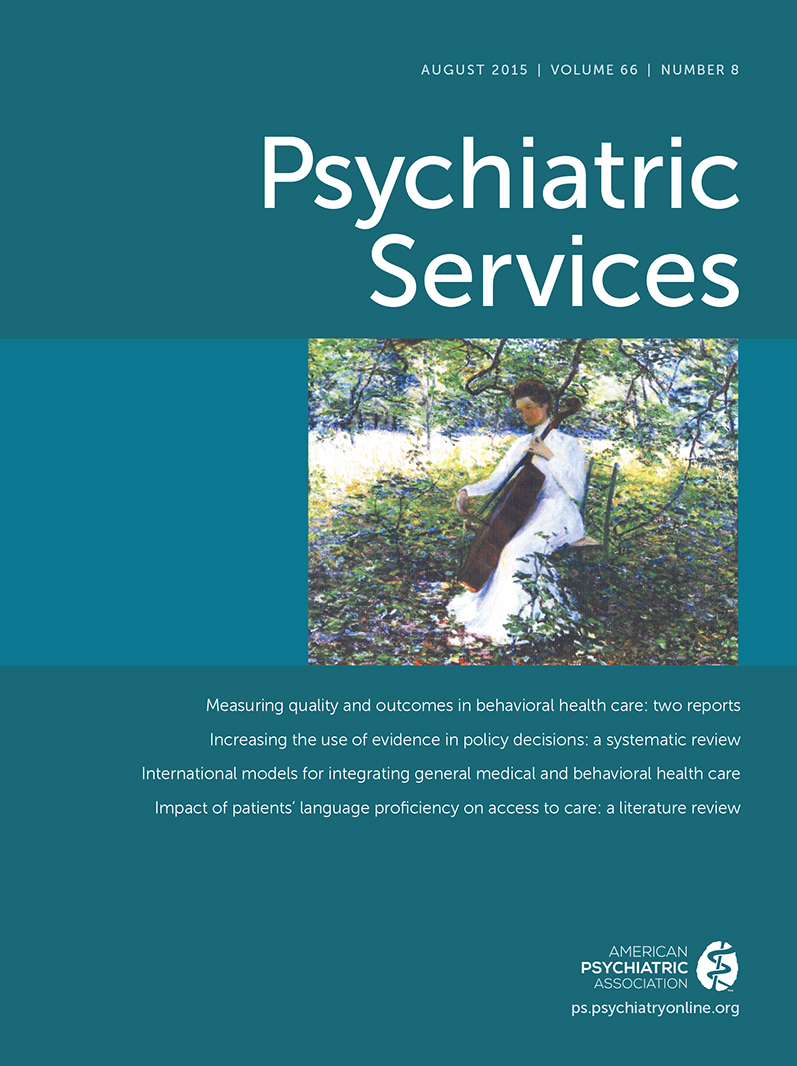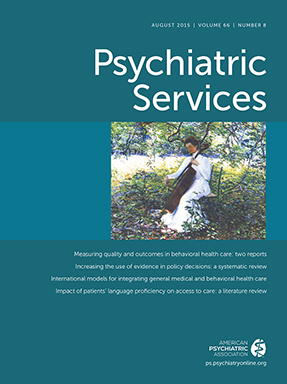Language Barriers and Access to Psychiatric Care: A Systematic Review
Abstract
Objective:
Methods:
Results:
Conclusions:
Methods
Results
| Study | Setting or data source | Sample | Main findings |
|---|---|---|---|
| Pumariega et al., 1998 (7) | School-based study of the mental health of a triethnic sample of junior and senior high school students in Texas | Hispanics (N=1,696), non-Hispanic whites (N=527), African Americans (N=97) | Hispanic youths who reported speaking English well had a greater lifetime number of counseling visits compared with those who did not (2.3 vs. 1.4, p<.01) |
| Abe-Kim et al., 2007 (8) | National Latino and Asian American Study (NLAAS) | Chinese (N=600), Filipinos (N=508), Vietnamese (N=520), other Asian Americans (N=467) | U.S.-born Asian Americans demonstrated higher rates of service use compared with their immigrant counterparts (6.2% vs. 2.2%); years in the United States and good English proficiency (EP) were not associated with service use |
| Alegria et al., 2007 (9) | NLAAS | U.S. and foreign-born Latinos, including Spanish speakers (N=1,348), bilinguals (N=332), English speakers (N=874) | Compared with U.S.-born Latinos and Latinos who spoke primarily English, foreign-born Latinos and Latinos who spoke primarily Spanish reported using less services overall (14.7% vs. 9.1%) and less specialty services (7.2% vs. 3.9%) |
| Sentell et al., 2007 (12) | 2001 California Health Interview Survey (CHIS) | English only (N=29,991), bilingual (N=9,243), no English (N=2,750) | Non–English-speaking individuals had lower odds of receiving needed services compared with those who spoke only English (OR=.28, CI=.17–.48) |
| Fortuna et al., 2008 (11) | NLAAS | Immigrant Latinos (N=1,630) | Good (vs. poor) EP (OR=19.6, CI=4.10–93.98) among those with a history of political violence was associated with an increased likelihood of using mental health services |
| Le Meyer et al., 2009 (15) | NLAAS | U.S.-born (N=127) and foreign-born (N=241) Asian Americans with a psychiatric disorder | U.S.-born patients had almost twice the rate of mental health services as immigrants (40% vs. 23%) |
| Coker et al., 2009 (14) | Healthy Passages (Alabama, California, and Texas) | Parents with good EP (N=3,693) or limited EP (LEP) (N=1,423) | Good EP was associated with lesser frequency of mental health care utilization among children (OR=.5, CI=.3–.6) |
| Bauer et al., 2010 (16) | NLAAS | Individuals with a lifetime mental disorder, including Latinos with LEP (N=342), Latinos with EP (N=439), Asian Americans with LEP (N=123), Asian Americans with EP (N=243) | Significantly fewer individuals with LEP accessed services in their lifetime (Latinos: LEP, 42.8% versus EP, 54.2%; Asians: LEP, 32.9% versus EP, 53.9%) |
| Kang et al., 2010 (10) | NLAAS | Vietnamese (N=520), Filipinos (N=508), Chinese (N=600), other Asians (N=467) | Respondents with EP were more likely than respondents with LEP to use at least one mental health service once in their lifetime (OR=1.15, CI=1.03–1.28) |
| Kim et al., 2011 (17) | National Latino and Asian American Study | Immigrants with psychiatric disorders, including Latinos (N=249) and Asians (N=123) | LEP significantly decreased the odds of using mental health services in the total immigrant group (OR=.30, CI=.14–64) and the Latino group (OR=.20, CI=.07–.58) but not among Asians |
| Sorkin et al., 2011 (13) | 2007 CHIS | Asian immigrants (Filipinos [N=258], Koreans [N=288], Japanese [N=268], Chinese [N=496], Vietnamese [N=175], and South Asians [N=87]) and non-Hispanic whites (N=19,098) | Asian immigrants with EP were more likely to report a visit to a mental health care professional (OR=.62, CI=.27–1.42) compared with non-Hispanic whites |
| Aratani et al., 2012 (18) | California Department of Mental Health’s Consumer and Services Information System | Mental health services users under age 25, including non-English speakers (N=23,231) and English speakers (N=36,573) | Non-English speakers were 55% less likely than English speakers to continue community-based mental health visits (OR=.45, CI=.43–.48) |
| Keyes et al., 2012 (19) | National Epidemiologic Survey on Alcohol and Related Conditions | Spanish-speaking (N=851), middle-low English-speaking (N=875), middle-high English-speaking (N=715), and English-speaking (N=951) Latinos | Individuals reporting strong vs. weak Latino ethnic identity (OR=.62, CI=.42–.92) and those reporting mostly or completely Spanish language/Latino social preference (vs. mostly English language /other social preference) (OR=.68, CI=.50–.94) were less likely to utilize services |
| Study | Setting or data source | Sample | Main findings |
|---|---|---|---|
| Stuart et al., 1996 (20) | All mental health services in Victoria, Australia | Inpatients (N=1,849), outpatients (N=3,987) | Poor English speakers underutilized specialist outpatient services; only 21% of patients with poor English proficiency (EP) and 31% of those with everyday English proficiency received psychotherapy, compared with 53% of fluent and 61% of native English speakers |
| Steel et al., 2006 (21) | 2 geographical catchment regions of Greater Western Sydney, New South Wales, Australia | Patients who made their first lifetime contact with mental health services, including English-speaking (N=80), Arabic (N=25), Chinese (N=27), and Vietnamese (N=14) patients | Patients with limited English fluency had a shorter median time to obtain mental health services (3.5 months) compared with the overall sample (6.3 months); English fluency was not associated with delays in receiving public mental health care |
| Chen et al., 2008 (23) | Canadian Community Health Survey, cycle 1.1 | Immigrant Chinese (N=879), Canadian-born Chinese (N=205), immigrant non-Chinese (N=3,439), Canadian-born non-Chinese (N=13,779) | Chinese immigrants with good EP were more likely than Chinese immigrants with LEP to have mental health consultations (OR=1.52, CI=.14–16.97) |
| Chen et al., 2009 (22) | Linked immigration and health administrative database, British Columbia, Canada | Total sample (N=100,773; N=48,877 males, N=51,896 females); English speaking: males, 56%, and females, 46% | Ability versus inability to communicate in English was associated with slightly higher rates of mental health visits among men (relative risk=1.10) but not among women |
| Koopmans et al., 2013 (24) | Dutch National Survey of General Practice | Dutch (N=7,772), Moroccans (N=364), Turkish (N=397), Antilleans (N=252), Surinamese (N=292) | All non-Dutch groups were clearly less likely to use outpatient mental health care services than their native counterparts, with the Moroccan group having the lowest likelihood, followed by Turks, Surinamese, and Antilleans (logit coefficients=–.980, –.745, –.675, and –.572, respectively) |
General Population in the United States
Patients With Psychiatric Disorders in the United States
Patients With Psychiatric Disorders in Australia
General Population in Canada
Patients With Psychiatric Disorders in the Netherlands
Discussion
Conclusions
Supplementary Material
- View/Download
- 27.46 KB
References
Information & Authors
Information
Published In
History
Authors
Funding Information
Metrics & Citations
Metrics
Citations
Export Citations
If you have the appropriate software installed, you can download article citation data to the citation manager of your choice. Simply select your manager software from the list below and click Download.
For more information or tips please see 'Downloading to a citation manager' in the Help menu.
View Options
View options
PDF/EPUB
View PDF/EPUBLogin options
Already a subscriber? Access your subscription through your login credentials or your institution for full access to this article.
Personal login Institutional Login Open Athens loginNot a subscriber?
PsychiatryOnline subscription options offer access to the DSM-5-TR® library, books, journals, CME, and patient resources. This all-in-one virtual library provides psychiatrists and mental health professionals with key resources for diagnosis, treatment, research, and professional development.
Need more help? PsychiatryOnline Customer Service may be reached by emailing [email protected] or by calling 800-368-5777 (in the U.S.) or 703-907-7322 (outside the U.S.).

